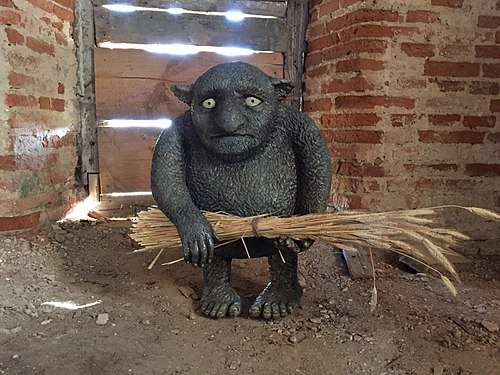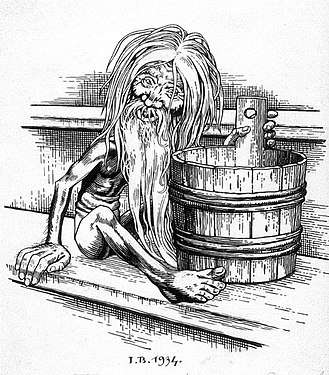Domovoy
In the Slavic religious tradition, Domovoy (Russian: Домово́й, literally "Household Lord"; also spelled Domovoi, Domovoj, and known by other, local variations of the same term and by other names) is the household god of a given kin. They are deified progenitors, that is to say the fountainhead ancestors of the kin.[2] According to the Russian folklorist E. G. Kagarov, the Domovoy is a personification of the supreme Rod in the microcosm of kinship.[3] Sometimes he has a female counterpart, Domania, the goddess of the household,[4] though he is most often a single god.[5] The Domovoy expresses himself as a number of other spirits of the household in its different functions.[6]
Etymology and belief
The term Domovoy comes from the Indo-European root *dom,[4] which is shared by many words in the semantic field of "abode", "domain" in the Indo-European languages (cf. Latin domus, "house"). The Domovoy have been compared to the Roman Di Penates, the genii of the family.[7] Helmold (c. 1120–1177), in his Chronica Slavorum, alluded to the widespread worship of penates among the Elbe Slavs. In the Chronica Boemorum of Cosmas of Prague (c. 1045–1125) it is written that Czech, one of the three mythical forefathers of the Slavs, brought the statues of the penates on his shoulders to the new country, and, resting on the mountain of the Rzip, said to his fellows:[2]
Rise, good friends, and make an offering to your penates, for it is their help that has brought you to this new country destined for you by Fate ages ago.
The Domovoy are believed to protect the well-being of a kin in any of its aspects.[5] They are very protective towards the children and the animals of the house, constantly looking after them.[8] These gods are often represented as fighting with one another, to protect and make grow the welfare of their kin. In such warfare, the Domovoy of the eventual winner family is believed to take possession of the household of the vanquished rivals.[9]
They are believed to share the joys and the sorrows of the family, and to be able to forebode and warn about future events, such as the imminent death of a kindred person, plagues, wars or other calamities which threaten the welfare of the kin. The Domovoy become angry and reveal their demonic aspect if the family is corrupted by bad behaviour and language. In this case, the god may even quit and leave the kin unprotected against illness and calamity.[9]
Iconography and worship

The Domovoy is usually represented as an old, gray-haired man with flashing eyes. He may manifest in the form of animals, such as cats, dogs or bears, but also as the master of the house or a departed ancestor of the given family,[10] sometimes provided with a tail and little horns.[11] In some traditions the Domovoy are symbolised as snakes.[12] Household gods were represented by the Slavs as statuettes, made of clay or stone, which were placed in niches near the house's door, and later on the mantelpieces above the ovens. They were attired in the distinct costume of the tribe to which the kin belonged.[7]
Sacrifices in honour of the Domovoy are practised to make him participate in the life of the kin, and to appease and reconcile him in the case of anger. These include the offering of what is left of the evening meal, or, in cases of great anger, the sacrifice of a cock at midnight and the sprinkling of the nooks and corners of the common hall or the courtyard with the animal's blood. Otherwise, a slice of bread strewn with salt and wrapped in a white cloth is offered in the hall or in the courtyard while the members of the kin bow towards the four directions reciting prayers to the Domovoy.[9]
The Domovoy is believed to be somehow connected with the house building itself, so that sacrifices are also practised when a family moved to a newly built house, in order to invite the god to inhabit it. In this case, a hen and the first slice of bread cut for of the first dinner in the new house are offered to the god and buried in the courtyard, reciting the formula:[13]
Our supporter, come into the new house to eat bread and to obey your new master.
Similar rituals are practised to invite a Domovoy to transfer from a house to another, and to welcome him.[13]
Other household deities
Other household gods, or expressions of the Domovoy, are:
- ① Dvorovoy — tutelary deity of the courtyard;[4]
- ② Bannik — "Bath Spirit", tutelary deity of the private or public bathhouses,[note 1] who corresponds to the Komi Pyvsiansa;[4]
- ③ Ovinnik (Belarusian: Joŭnik) — "Threshing Barn Spirit";[15]
- ④ Prigirstitis — known for his fine hearing;[4]
- ⑤ Krimba — household goddess among the Bohemians;[4]
- ⑥ The lizard-shaped Giwoitis.[4]
Alternative naming
Some English-speaking authors interpret the name domovoy as "house elf". [16][17]
The Slavic languages and their local forms have variations of the term Domovoy and alternative names to describe the household god, including:
- Děd, Dĕdek, Děduška[2] (names of this form convey the concept of "grandfather")
- Did, Didko, Diduch, Domovyk (Ukrainian)[7]
- Damavik (Belarusian)
- Dedek, Djadek (Czech)[7]
- Šetek, Šotek (Bohemian)[7]
- Skřítek[7]
- Škrata, Škriatok (Slovak)[18]
- Škrat, Škratek (Slovenian)[18]
- Skrzatek, Skrzat, Skrzot (Polish)[18]
- Chozyain, Chozyainuško (Russian)[12] (meaning literally "master" and "little master")
- Stopan (Bulgarian)[12]
- Domovníček, Hospodáříček (Bohemian)
- Domaći (Croatian)[12]
- Zmek, Smok, Ćmok (snake form)[8]
The female counterpart Domania can appear as:
Gallery of household deities
 Sculpture of Ovinnik ("Threshing Barn Spirit"), by Belarusian sculptor Anton Shipitsa based on illustrations by Valery Slauk
Sculpture of Ovinnik ("Threshing Barn Spirit"), by Belarusian sculptor Anton Shipitsa based on illustrations by Valery Slauk Bannik ("Bath Spirit"), by Ivan Bilibin
Bannik ("Bath Spirit"), by Ivan Bilibin_-_Kikimora.jpg)
See also
| Wikimedia Commons has media related to Domovoy. |
- Ancestor worship
- Deities of Slavic religion
- Household deity
- Slavic paganism
- Slavic Native Faith
Notes
- Slavic bathhouses (banya)—which are like saunas, with an inner steaming room and an outer changing room—have their tutelary god, Bannik. The Slavic bathhouse is a place where traditionally women gave birth and practised divination, thus a receptacle of vital forces. The third or fourth firing is dedicated to Bannik, who is invited to the bathhouse with his forest spirits. In the bathhouse, Bannik is traditionally consulted as he is considered able to forebode the future.[14]
References
Footnotes
- Máchal 1918, pp. 244 ff.
- Máchal 1918, p. 240.
- Ivanits 1989, p. 14.
- Mathieu-Colas 2017.
- Máchal 1918, p. 241.
- Ivanits 1989, p. 61.
- Máchal 1918, p. 244.
- Máchal 1918, p. 247.
- Máchal 1918, p. 242.
- Máchal 1918, pp. 240–241.
- Ivanits 1989, pp. 49–54.
- Máchal 1918, p. 246.
- Máchal 1918, p. 243.
- Alexinsky, G. (1973). "Slavonic Mythology". New Larousse Encyclopedia of Mythology. Prometheus Press. pp. 287–288.
- Ivanits 1989, p. 58.
-
Jones, William (1898). Credulities Past and Present: Including the Sea and Seamen, Miners, Amulets and Talismans, Rings, Word and Letter Divination, Numbers, Trials, Exorcising and Blessing of Animals, Birds, Eggs, and Luck. London: Chatto & Windus. p. 472. Retrieved 2019-06-02.
One way of pacifying an irritated 'domovoy,' or house elf, among the Russians [...].
-
Arrowsmith, Nancy (2009) [1977]. "Dusky elves". Field Guide to the Little People: A Curious Journey Into the Hidden Realm of Elves, Faeries, Hobgoblins & Other Not-so-mythical Creatures. Woodbury, Minnesota: Llewellyn Worldwide. p. 69. ISBN 9780738715490. Retrieved 2019-06-02.
The Domoviye are among the most important Slavic house elves, although their name is sometimes used for other species. [...] The Domoviye (singular Domovoy) do favors for the family, stealing food and grain from the neighbors, cleaning the house, and taking care of the animals.
- Máchal 1918, p. 245.
Sources
- Ivanits, Linda J. (1989). Russian Folk Belief. M. E. Sharpe. ISBN 9780765630889.CS1 maint: ref=harv (link)
- Máchal, Jan (1918). "Slavic Mythology". In L. H. Gray (ed.). The Mythology of all Races. III, Celtic and Slavic Mythology. Boston. pp. 217–389.CS1 maint: ref=harv (link)
- Mathieu-Colas, Michel (2017). "Dieux slaves et baltes" (PDF). Dictionnaire des noms des divinités. France: Archive ouverte des Sciences de l'Homme et de la Société, Centre national de la recherche scientifique. Archived from the original (PDF) on 4 August 2017. Retrieved 24 May 2017.CS1 maint: ref=harv (link)
.jpg)
.jpg)
